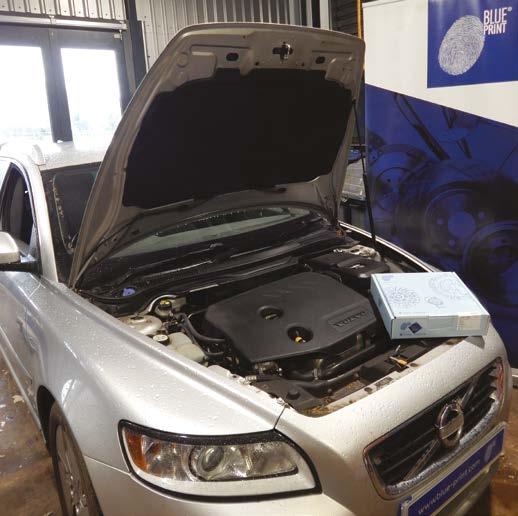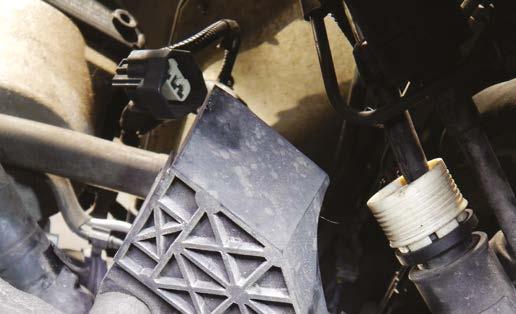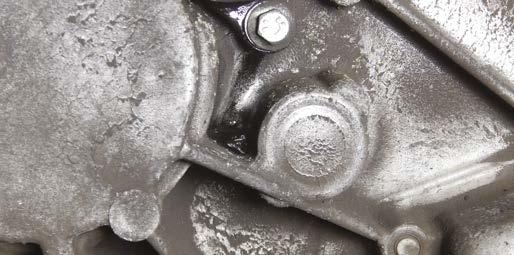
5 minute read
Volvo V50 clutch case study

Volvo V50 Case Study
Blue Print tackles a suspected leaking clutch CSC within its workshop
The Volvo V50 estate and the S40 saloon models were introduced in 2004 and were manufactured with a number of different engine and transmission options, until 2012. This Volvo model shared its platform with many other Volvo, Ford and Mazda models, making mechanical repairs on this vehicle seem familiar, even if this model is not an everyday visitor to an independent workshop.
The vehicle featured in this article is a 2011 model, fitted with the 1.6 litre diesel PSA group engine and a six-speed GETRAG manual transmission, and has Stop/Start, as it is a DRIVEe model.
The owner of the vehicle had reported some difficulty with the clutch operation, which was suspected to be a hydraulic fault, due to the loss of fluid. However, there were no obvious external fluid leaks from the clutch master cylinder or associated pipes, hoses or connections. Therefore, the fault was suspected to be a leaking clutch concentric slave cylinder (CSC), which required the removal of the transmission for inspection and diagnosis.
The vehicle was brought into the workshop, the bonnet was opened and the engine cover along with the battery cover, battery, battery tray and air cleaner assembly were removed, as well as the DPF pressure sensor, which is attached to the battery tray. This was to provide access to the top of the engine and transmission. All cables associated with the battery were unclipped and secured until reassembly.
With the top of the transmission visible, the two gear selector cables were unclipped from their mounting points and were secured out of the way. The reverse lamp switch and the neutral switch wiring harness connectors were unclipped, along with the CSC hydraulic pipe connection. The open end of the connector was sealed with a plastic cap to stop any excess fluid from leaking out, see Figure 1.
Figure 1
The main wiring harness that goes across the top of the transmission was eased back to reveal the top bell housing bolts, these were removed with two of the starter motor bolts that were accessible from the top of the transmission.


The diesel particulate filter (DPF), fitted to this engine needs to be lowered, in order to gain access to one of the front bell housing bolts. The temperature and lambda sensor wiring harness were disconnected and the differential pressure sensor pipes. The air intake pipe, heat shield and retaining clamp were removed, and then the DPF can be eased down to give clearance for the removal of the bell-housing bolt, see Figure 2.
The vehicle was raised to a suitable height and the front wheels were then removed, this gave access to the hub retaining bolts, which were also removed. Then, the left front wheel arch liner was also removed, to improve clearance ready for the removal of the transmission.
The vehicle was raised again and the transmission oil was drained, followed by the removal of both front lower arm ball joints, from the hub assembly. This was followed by the removal of the left driveshaft from the transmission. A supporting centre bearing retains the right driveshaft; this needs to be unbolted before the driveshaft can be removed.
Figure 2
Figure 3

Next, was the removal of the gearbox torque mounting, followed by the gear selector cable bracket. This was to give extra clearance, to help when removing the transmission, see Figure 4.
Figure 4
The leaking CSC was removed. Then, the bell housing and the input shaft were thoroughly cleaned of all grease, dirt and old friction fibres, from the previous clutch and the input shaft seal was inspected before fitting the new CSC (ADM53635).
The clutch pressure plate and friction disc were removed and inspected, along with the condition of the dual mass flywheel (DMF). The friction disc was very close to being worn out and there was a lot of bluing on the friction surface of both the pressure plate and flywheel. Therefore, all parts required replacing. Clutch kit (ADF123081) and DMF (ADBP350003) were selected for this repair, the original flywheel was removed from the engine and the rear main oil seal was inspected for any oil leaks before fitting the new flywheel.
The new flywheel is an updated design and is supplied complete with new bolts. It is essential that the new bolts supplied are used, because they are of a different length to the original bolts. The new flywheel bolts were tightened to the recommended settings and the clutch kit was aligned and fitted to the flywheel.
The transmission input shaft splines were lightly greased in preparation before installation, see Figure 6.
The transmission was aligned to the engine and secured in place with a few of the bell housing bolts. This was followed by refitting all of the parts to the transmission, and all of the other parts that were removed in the process of the removal of the transmission. Then all of the bolts and fixings were tightened accordingly. The transmission was filled with fresh oil through the level plug located on the front of the transmission, until the level was reached and then the plug was refitted.
Following this, the brake/clutch fluid reservoir was topped-up with fresh fluid, and then the new CSC was bled of any excess air.
Finally, the battery tray along with all the associated wiring were refitted, and then the battery and all the other covers were refitted. This was followed, by resetting the clock and a check of the clutch pedal operation, before a road test was carried out to check that the clutch was back to full operational order.



The engine was supported, the top transmission mount was released, and then the last of the bell housing bolts were removed, before separating the transmission from the engine. The transmission was lowered to the floor and inspected. Upon inspection of the bell housing, it became obvious that the CSC had been leaking, which was the cause of the loss of fluid in the clutch system and the poor pedal performance, see Figure 5.







